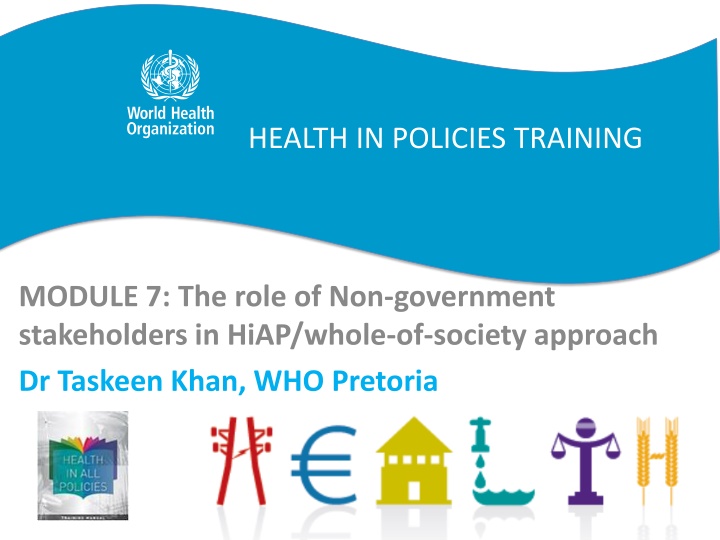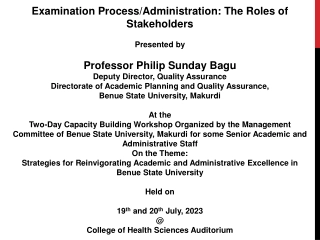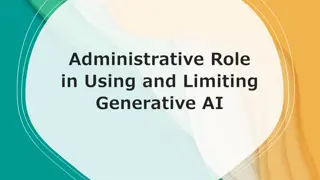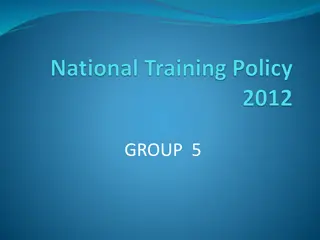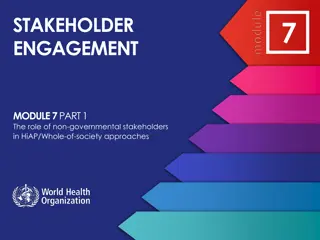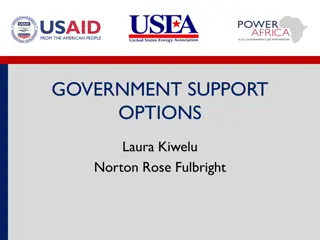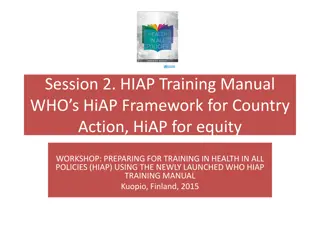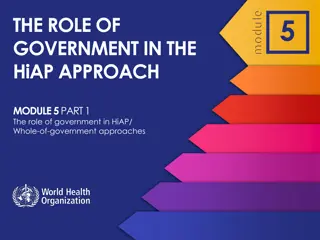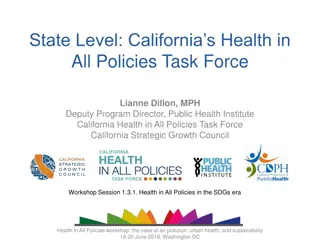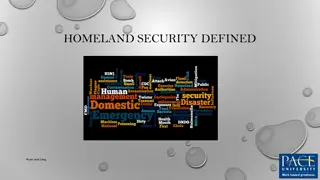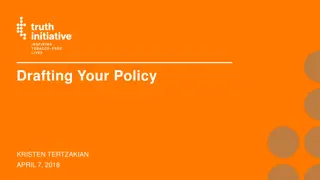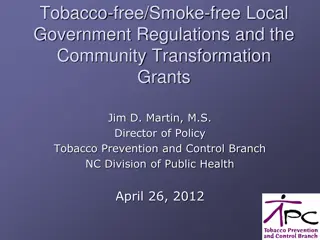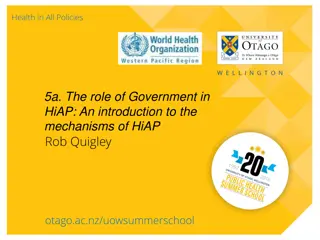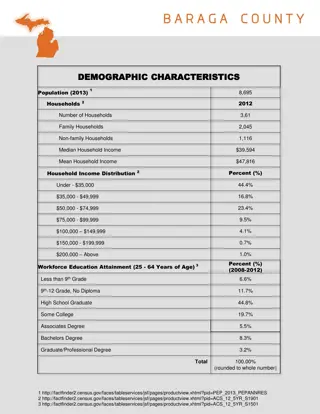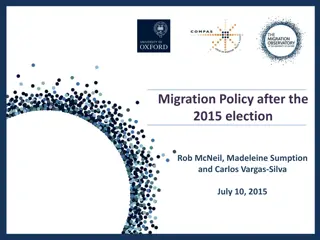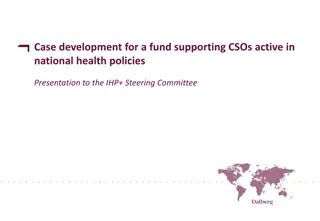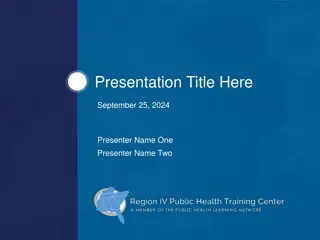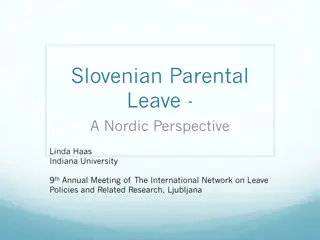Role of Non-government Stakeholders in Health Policies Training
Explore the pivotal role of non-government stakeholders in Health in All Policies (HiAP) and a whole-of-society approach. Understand their definition, importance, benefits, challenges, and principles of effective engagement. Learn how primary and secondary stakeholders differ and the significance of NGOs in promoting health action across sectors.
Download Presentation

Please find below an Image/Link to download the presentation.
The content on the website is provided AS IS for your information and personal use only. It may not be sold, licensed, or shared on other websites without obtaining consent from the author.If you encounter any issues during the download, it is possible that the publisher has removed the file from their server.
You are allowed to download the files provided on this website for personal or commercial use, subject to the condition that they are used lawfully. All files are the property of their respective owners.
The content on the website is provided AS IS for your information and personal use only. It may not be sold, licensed, or shared on other websites without obtaining consent from the author.
E N D
Presentation Transcript
HEALTH IN POLICIES TRAINING MODULE 7: The role of Non-government stakeholders in HiAP/whole-of-society approach Dr Taskeen Khan, WHO Pretoria
Overview Definition of non-government stakeholders Importance Role of non-government stakeholders in HiAP Benefits and challenges of consulting widely Principles of effective stakeholder engagement Purpose of a stakeholder analysis Example
An integrated policy approach within government and international organizations, as well as a commitment to working with civil society and the private sector and across settings, are essential if progress is to be made in addressing the determinants of health. WHO Bangkok Charter for Health Promotion
Who are non-government stakeholders?
DEFINITION OF NON-GOVERNMENT STAKEHOLDERS a person, or group of persons, who have an interest or concern in a particular process or issue due to direct or indirect involvement. Examples include: research institutes, labour unions, professional associations businesses. government ministries, politicians, non-government organizations, religious organizations
PRIMARY VS SECONDARY PRIMARY One who, without continuing participation, the policy or issue could not succeed or be addressed E.g. schools might be a primary stakeholder when dealing with the issue of healthy foods for children SECONDARY One who has some influence or is affected by the policy or issue However, their engagement is not essential to address the issue or to take policy action E.g car manufacturers might be a secondary stakeholder when addressing road safety and drink driving
IMPORTANCE OF NGO Play a critical role in promoting health action across sectors due to their significant influence on affairs of the state. Usually led by passionate and committed individuals with great advocacy skills and the capacity to influence public opinion Provide data and evidence on health and equity issues, which is important for identifying vulnerable populations and the need for action Provide useful resources and technical expertise in the development of policies and plans Member States seeking to implement health action across sectors should seek to engage and include potentially relevant NGOs as much as possible
CONFLICTS OF INTEREST Private sector key to achieving specified goals, but can also contribute to negative impacts on health and their risk factors 1st step to determining appropriate engagement, while managing potential conflicts of interest: understanding potential contributions and understanding impacts on health
TRIANGLE THAT MOVES MOUNTAINS Combination of knowledge, social pressure and government leadership has been called the triangle that moves mountains
WHAT DO YOU THINK ARE THE ROLES OF NON-GOVERNMENT STAKEHOLDERS?
ROLES OF NGO Support the ability of community members to fully participate in community action for health; For example, Promoting health and policy literacy; Training leaders in techniques to support and to enable informed community participation, and engagement with decision-making; and Implementing and evaluating community action for health.
Continued Build on existing relationships at the local level for example, between local government and communities to engage citizens in action across sectors. Identify opportunities to engage non-state actors, including the private sector, in regular policy dialogue to facilitate shared understanding of the health agenda.
BENEFITS OF STAKEHOLDER CONSULTATIONS Assessing support and opposition to a policy Giving government activities visibility and legitimacy Empowering the marginalized Increasing collaboration and more efficient use of resources Ensuring the sustainability of interventions.
WHAT ARE THE CHALLENGES OF INVOLVING STAKEHOLDERS?
CHALLENGES OF STAKEHOLDER CONSULTATIONS Prolonging policy-making Increasing costs of intervention Polarizing interest groups Creating unmanageable expectations
WHAT PRINCIPLES SHOULD UNDERPIN STAKEHOLDER CONSULTATION?
PRINCIPLES OF STAKEHOLDER CONSULTATIONS Empowerment Accountability Transparency Cost-effectiveness Resources
PURPOSE OF STAKEHOLDER ANALYSIS A process of systematically gathering and assessing qualitative information about stakeholders. Helps to categorize their relative importance as actors and Helps to develop strategies on how to involve them in the development and/or implementation a HiAP policy or programme Many templates and tools available for analysing stakeholders but they share this essential purpose
STAKEHOLDER ANALYSIS EXAMPLE: MULTISECTORAL NUTRITION PROGRAMME IN NEPAL
DISCUSSION The outcome document of the High-Level Meeting of the UN General Assembly on the Comprehensive Review and Assessment of the Progress Achieved in the Prevention and Control of NCDs (A/RES/68/300) asked WHO to develop an approach : to registering and publishing contributions of the non-state actors (including the private sector and civil society) towards achieving the global voluntary NCD targets
WHO AS AN EXAMPLE Using WHO as an example, a framework for non-state actor engagement is being developed to clarify: how to capitalize on the beneficial contributions of non-state actors to health action across sectors; the distinctions between real and perceived conflicts of interest, and between individual and institutional conflicts of interest; how WHO should deal with actors who do not share the interests of WHO, or with situations where secondary interests undermine public health; and how WHO should distinguish between direct and indirect interests.
